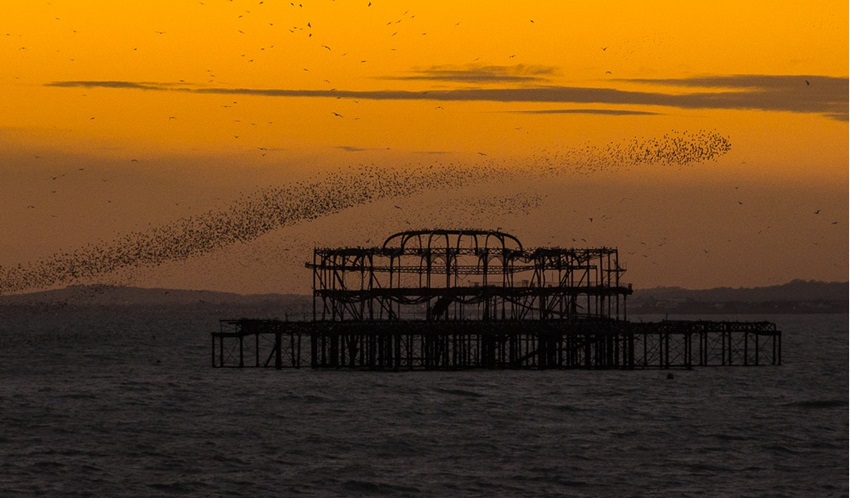.
Sunday Morning Flock of Starlings
He saw, while driving down the roadway, off 288,
a flock of starlings at the electrical substation gate.
It was on Sunday morning, and with serious intent,
they dropped down from a murmuration, in precise descent.
In҇ a dazzling swirl of undulations—unambiguous—
with closing wings, they sank so swiftly, it was marvelous.
Coordinating movements with their seven nearest birds,
the mass achieved a scale-free correlation with no words;
and gracefully, as well as synchronously, paused to stand,
before they took off strenuously to another land.
.
.
Bruce Dale Wise is a poet and former English teacher currently residing in Texas.















Interesting image of the birds magnified by superb use of words and rhyme.
Mr. Peterson notes, dare I say, the imagistic direction of the poem; and I am always thrown back, to the failure of my depictures [sic] of reality; in this case, the briefest of interludes, on January 21st 2024. If there was not abundant recompense for such attempts, however, I do not think I should even undertake them.
If it is any consolation, reality when described conjures up images in the reader, since we did not see them.
Lovely imagery and rhyme; vivid, like a scene from a novel.
Thanks for the read.
Although “Sunday Morning Flock of Starlings” may seem, as Mr. Freeman has pointed out, like “a scene from a novel”, it comes from pure experience, and only peripherally alludes to the work of Wallace Stevens; though as a writer, who likewise has written a novel, Mr. Freeman’s observation does point out the directional position of this particular poem; for, I, too, have frequently used prose writers, as, for example, Dryden’s translation of Plutarch, in an epyllion, or more recently, snippets from Tolstoy’s “War and Peace” to Hunter S. Thompson’s “Fear and Loathing in Las Vegas”, the latter startling with its insistent insouciance.
What a beautiful description of a majestic event — a “precise descent”. I wish I had seen it! Birds are such amazing artists!
Part of what made it extraordinary to me was it occurred while I was in motion. As I was slowing down to begin with, in order to turn off a 50mph roadway, I slowed even further down (there was no traffic) to catch the whole murmuration; and though I had not thought the sight of those starlings “majestic”, as Ms. Erlandson has briefly noted, I think that is an excellent term to express that event.
Evidently murmuration occurs primarily at sunset as the birds congregate before they settle down to roost. Also, it appears that the swarming movement confuses predators.
Ms. Corey is pointing out a couple of facts about murmurations; and that is exactly what the author was trying to do as well, as, for example, in pointing out, in L7, how starlings can do this to begin with. As Ms. Corey points out, because murmurations are more typical at evening time, to have seen those starlings in the morning may have been even more startling than the author realized.
Beautifully done, Bruce. I notice that you are as precise as the starlings here, in specifying time, place, circumstance, and a single observer. As Paul Freeman says, this could be a poetic interlude in a novel. The ten lines, differentiated in rhythm and syntax, make up a dizain of starling-like smooth flow, with precisely the same number of accents (7 x 10) as a pentameter sonnet (5 x 14). To me, it seems at once freer and more compact than a sonnet.
Your observations are quite accurate, Margaret. This poem is a tennos, a form invented by the author.
Ms. Coats notices the specificity of setting (time and place), character (narrator and/or observer), point of view (third person), circumstance (subplot with concomitant resolution), and general theme (nature’s precision). The tone is serious, albeit, dazzling; while the conflict is subtle, i.e., “strenuous”…
The poem contrasts with the ending of Wallace Stevens’ “Sunday Morning”, where he describes the movement of birds as “ambiguous undulations”; here the author flips the two words, negates one, and uses a Dickinsonian dash. At the beginning of L5, the author does slightly differentiate the rhythm; and I was happy Mr. Mantyk left the symbol in; however, there was an editorial alteration, e.g., with an elision omission in L2. It is understandable, as Mr. Mantyk is imbued with traditional poetry; and he has explained to me how he does not appreciate some of the Cummingsesque typography I am wont to use.
I think th’ iambic hexameters, if not “freer” than a sonnet, in the hands of, say, Shakespeare, are indeed “more compact”; for the movement has been stilled by no volta; and that may give the illusion of a “freer” feeling. It certainly allows for a longer line. The tennos, a poem of ten lines, like a dizain, is, however, in iambic hexameters. It did come out of a sonnet’s structure [tennos is sonnet spelled backwards]; but it has led to other forms, like the dodeca, and has also been used stanzaic’lly in much longer poems, such as “Coronal” (360 lines).
It is not surprising that Mr. Anderson recognized the tennos form. He is one of the few who has used the form once. However, I did notice an error in the description of the tennos that I gave to Ms. Coats. Like Miss Prism in Wilde’s “The Importance of Being Earnest”, in “a moment of mental abstraction, for which I can never forgive myself” I wrote “hexameter”, when I most definitely meant “heptameter”.
Bruce,
Nice to see you, again, and a pleasure to read some of what you are creating these days. It’s been a while. Capturing descriptive motion in words and verse is a challenge that you have well-met in this poem. Anyone who has ever been transfixed in watching starlings perform their collective shape-shifting dance will be able to re-see it as they read your words. Thanks for the verbal video!
As Mr. Tweedie points out, the author attempted “capturing descriptive motion in…verse”; and in this brief poem Mr. Tweedie can read what the author is “creating these days”. [But, of course, it is limited, as the author writes well over 50,000 words per year.]
First off, this is a fairly typical poem of the author in its prosaic prosody: “…th’ electrical substation gate”, etc. Of the three sentences in “Sunday Morning Flock of Starlings”, it is the third sentence that works most for the author. Here he gets to use learnèd latinate vocabulary for his depicturing [sic] with phrases, like “coordinating movements” and scale-free “correlation”; throughout the poem, one internal rhyme, linked to “serious” in L3, continues to L10, in the “gracefully” contrarian “strenuously”. Finally, he concludes with a pun, which is what the author finds the most “pleasure” in.
I have much praise, one nit, and one observation. I love the choice of long, dense lines– dense but not heavy, dense but nimble if that makes sense. What I’m trying to get at is that the verse is much like the flock itself. The nit is that although I fall into it as well, I dislike pronouns without antecedents. The observation is that this poem can pretty well equally describe/symbolize the inspiration/writing process to a pretty high degree of granularity.
Mr. Kemper states he “loves the choice of long, dense lines—dense but not heavy, dense but nimble…”; however, there really was no connection of the experience to the form; for the tennos is the starting point for the author, as his work is overwhelmingly in this form, partly because its possibilities are enormous. Of course, it was a long road to get here, one that went through poets Blake, Coleridge, Whitman, Hopkins, Dickinson, T. S. Eliot, the balladeers, etc., as well as innumerable prosets. [There were so many, it may be impossible to name them all.] Nevertheless, I like the “form” here, at the moment; so this “choice” is really a much larger one than Mr. Kemper is suggesting; but perhaps he dislikes the form itself. I have found that most PostModernist and NewMillennial editors do not like the form.
I do agree with Mr. Kemper when he speaks of “dense, but nimble” lines. That is the ideal. In the context of being a fond reader of Vergil and Horace, among other writers, placement of words is extremely important. If the last word in a Góngora poem is “nueve”, it matters. I must admit I do not understand specific’lly which pronouns Mr. Kemper suggests lack antecedents; after all, the exposition is very clear: “He saw, while driving down the roadway, off 288, a flock of starlings…”; and that is exactly what all the pronouns evolve from. If, on the other hand, Mr. Kemper believes the pronouns simultaneously refer to the verse itself, with a “high degree of granularity”, then that is a major metaphorical success for the author, since that was not his intention, and he can revel in that extraordinary position.
I love to see birds in murmuration. You express it well in your poem.
Lucia
What an author finds interesting about his or her work may not be what a reader finds interesting. For example, I do not think the poem was as successful as some of the rather surprising word-connections Ms. Haase shows in her poetry, id est, her surreal attempts to deal with the rich, naturally beautiful aspects of reality; but that was not my intention. Adjectives and adverbs, like “marvelous” and “gracefully”, were used really for their latinity. I was mainly fighting Modernist American poet Wallace Stevens, in “Sunday Morning”, but at the same time only allowing a tennos worth of words. In that I feel I was fairly successful, though I doubt anybody else would feel so.